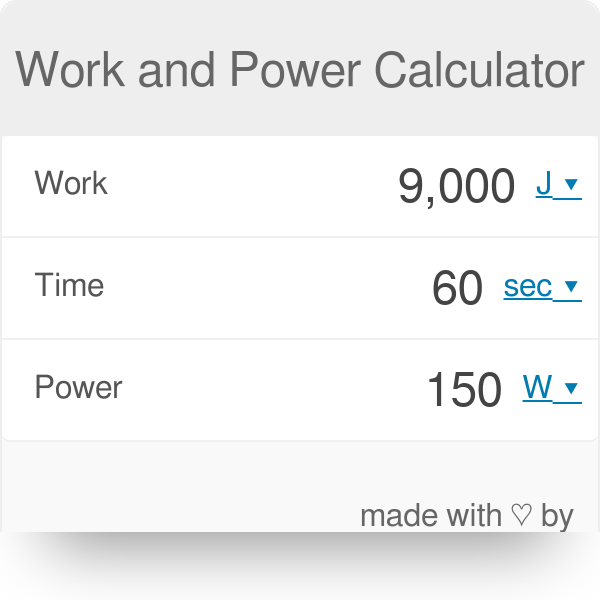


The product of force and velocity, or the divide of work and time, is power. Multiplying the force with the displacement. What is the formula for calculating work energy and power? When the letter k appears in front of a unit, it signifies the unit has been multiplied by 1,000.ģ. The watt (W) is a unit of power that measures the number of joules of work done per second.Ī kJ is equal to 1,000 joules (kilojoule). The kWh is another standard unit of work. The joule (J) is a unit of work that is equal to kgm2/s2 in SI units. What units are used to calculate work and power? Find similar concepts related to physics all under one roof at and resolve all your doubts as a part of your homework or assignment. You may also use our power calculator to look for work simply enter the power and time values. Step 3: Work divided by time equals power.Step 2: Choose a time when the work will be completed.You can either type this value into our calculator directly or use the advanced option to calculate it using force and displacement. Step 1: Determine the value of your work.
POWER CALCULATOR PHYSICS HOW TO
How to use the Work and Power Calculator? The formulas for calculating power and work are given below It is expressed in units Watts(W), which is equivalent to SI unit of kg The higher a device's power, the more work it can do in a given amount of time. The rate of change of work, or the amount of work completed in a given amount of time, is referred to as power. It is expressed in joules (J) or kilowatt-hours (kWh). Between these two quantities, it's a dot product. It could be the energy expended lifting big bags up the stairs or the kinetic energy expended when the body moves.įorce multiplied by the distance an object goes is how it's usually computed. Try out our Ohm’s Law Calculator in our Tools section.In physics, the quantity of energy required to move an object a specific distance is referred to as work. Joule’s Law: P = I 2R P = IE P = E 2/R.Power measured in watts, symbolized by the letter “W”.

However, these power equations are so commonly associated with the Ohm’s Law equations relating voltage, current, and resistance (E=IR I=E/R and R=E/I) that they are frequently credited to Ohm. This discovery, published in 1841, followed the form of the last equation (P = I 2R), and is properly known as Joule’s Law. If we only know current (I) and resistance (R):Ī historical note: it was James Prescott Joule, not Georg Simon Ohm, who first discovered the mathematical relationship between power dissipation and current through a resistance. Using algebra again to manipulate the formula, we can take our original power formula and modify it for applications where we don’t know both voltage and current: If we only know voltage (E) and resistance (R): You can check this by dividing 432 watts by 108 watts and seeing that the ratio between them is indeed 4. Why is this? Because power is a function of voltage multiplied by current, and both voltage and current doubled from their previous values, the power will increase by a factor of 2 x 2, or 4. Notice that the power has increased just as we might have suspected, but it increased quite a bit more than the current. What does Increasing a Battery’s Voltage do to Power? Indeed, it has: we now have 12 amps of current instead of 6. This stands to reason: if I = E/R, and we double E while R stays the same, the current should double. The lamp is still providing 3 Ω of electrical resistance to the flow of current. Now, the battery’s voltage is 36 volts instead of 18 volts. Likewise, the power will increase as well: Intuition should tell us that the circuit current will increase as the voltage increases and the lamp resistance stays the same. Let’s try taking that same circuit and increasing the battery’s voltage to see what happens.

This tells us that the lamp is dissipating (releasing) 108 watts of power, most likely in the form of both light and heat. Now that we know the current, we can take that value and multiply it by the voltage to determine power: Using Ohm’s Law to determine current, we get: In the above circuit, we know we have a battery voltage of 18 volts and a lamp resistance of 3 Ω. How to Use Ohm’s Law to Determine Current We’ve seen the formula for determining the power in an electric circuit: by multiplying the voltage in “volts” by the current in “amps” we arrive at an answer in “watts.” Let’s apply this to a circuit example:


 0 kommentar(er)
0 kommentar(er)
